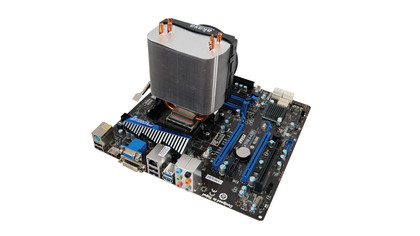How to upgrade your Linux box for Steam
Beef up your Linux box for some extra FPS
If your memory is too slow for your processor, it either won't work or won't make best use of it. If it's faster, your only loss is paying too much. We used 4GB of G.Skill Ripjaw Gaming Series Memory (F3-12800CL7D), which has a clock speed of 1600 Mhz. Most motherboards will now support up to 32GB of memory.
5. SATA ports (2 and 3)
Very few motherboards come with the old IDE connectors for storage and optical drives. Everything now needs to use the much easier SATA connectors.
Despite all using the same cables, most devices are SATA2-compatible, which has a theoretical transfer limit of 3Gb/s, although all the boards we looked at offered SATA 3 as well, which will double this limit if you use compatible storage.
6. USB ports
Similarly, now that everyone has settled into using USB 2 connections for all of their devices, this is being slowly supplanted by USB 3. USB 3 boosts the 480Mb/s transfer speed of the older standard to 5Gb/s, which both puts it on a par with SATA 3, and makes it considerably faster than Firewire 800.
However, data transfer is never a completely black and white subject. Instead, it depends on your operating system, the devices involved, the drivers for your chipset and your usage. Many video editors are convinced that Firewire 800 delivers better performance than USB 3, for instance.
Get daily insight, inspiration and deals in your inbox
Sign up for breaking news, reviews, opinion, top tech deals, and more.
7. PCI slots
You're now likely to connect your expansion cards using the PCI Express x1 or the PCI Express x16 slots. The latter usually includes one high-powered slot for a graphics card, labelled as 'PCIEX16' and situated closest to the CPU, and some slower slots, labelled 'PCIE4'.
8. Video out
Now that many Intel and AMD platforms contain a GPU for graphics, it's common to find a video out connector. These are usually either DVI or HDMI connectors for easy interfacing with a television or modern screen, and the latter will also contain the digital audio output.
9. Audio out
You'll find analogue outputs as well as digital, usually in the form of optical or coaxial connections for an amplifier. Many motherboards use a Realtek chipset for sound, and this can produce multi-channel audio. The best bet is to keep audio within the digital domain, as it won't require any conversion if you're playing movies with a compatible amplifier, and won't suffer interference.
10. LAN
You're probably familair with Ethernet/wired network connections. Transfer limits haven't changed for a while, which means the speed of your network depends on the speed of the connected devices. All modern boards will support 10/100 and 1000 Mb/s (Gigabit) connections.
CPUs
There's more to processing power than the speed of the processor

There was a time when CPU performance came down to one thing: clock speed. A faster CPU could perform more operations in a given amount of time, and therefore could complete a given task before a slower CPU.
Clock speed is measured in Hertz, which are the number of instructions that can be completed in a second (OK, we're simplifying a bit here. Some instructions take more than one clock cycle). Most modern processors run at around a few Gigahertz (1GHz = 1'000'000'000Hz).
What constitutes an instruction depends on the type of processor. We will look at the x86 processor family, which are used in most desktops and laptops. This instruction set started in 1978 on the 16-bit Intel 8086 chip. The main instructions have stayed the same, and new ones have been added as new features have been needed.
The ARM family of processors (used in most mobile devices) uses a different instruction set, and so will have a different performance for the same clock speed. As well as the number of operations, different processors perform the operations on different amounts of data.